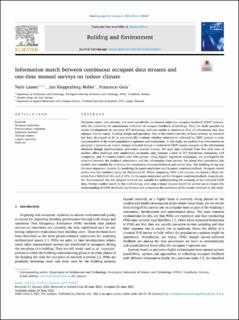| dc.contributor.author | Lassen, Niels | |
| dc.contributor.author | Møller, Jan Kloppenborg | |
| dc.contributor.author | Goia, Francesco | |
| dc.date.accessioned | 2021-07-22T07:36:57Z | |
| dc.date.available | 2021-07-22T07:36:57Z | |
| dc.date.created | 2021-07-02T10:54:49Z | |
| dc.date.issued | 2021 | |
| dc.identifier.citation | Building and Environment. 2021, 204, . | en_US |
| dc.identifier.issn | 0360-1323 | |
| dc.identifier.uri | https://hdl.handle.net/11250/2765051 | |
| dc.description.abstract | Occupant-centric data streams, and more specifically continuous subjective occupant feedback (CSOF) systems, offer the possibility for autonomous collection of occupant feedback in buildings. They are made possible by recent developments in pervasive ICT technology and can enable a continuous flow of information that may enhance human-centric building design and operation. Due to the relative novelty of these systems, no research has been developed so far to systematically evaluate whether information collected by CSOF systems is truly representative of the entire population's opinions and evaluations. In this study, we analyze how information on occupant's opinions on indoor climate collected though a multi-level CSOF system compare to the information obtained though simultaneously performed manual surveys. We used data collected from five field tests in modern office buildings with uninformed occupants, and compare a total of 317 Satisfaction evaluations, 124 Complaints, and 44 Control actions with 546 surveys. Using logistic regression techniques, we investigated the relations between the feedback information and the information from surveys. We found that cumulative link models were suitable for modeling the relationship between feedback and survey data. The Building ID tag was the most important variable for modeling Occupant satisfaction and Occupant complaint feedback. Occupant control actions was best modeled using the Workplace ID. When comparing CSOF with surveys, we found a Mean Absolute Error (MAE) of 16% and of 12%, for Occupant satisfaction and for Occupant complaint feedback, respectively. We demonstrated that the adopted methods are suitable for understanding the meaning of the collected CSOF data. Further studies based on this methodology and using a larger dataset should be carried out to deepen the understanding of CSOF feedback significance and to increase the soundness of the results obtained in this study. | en_US |
| dc.language.iso | eng | en_US |
| dc.publisher | Elsevier Ltd. | en_US |
| dc.rights | Navngivelse 4.0 Internasjonal | * |
| dc.rights.uri | http://creativecommons.org/licenses/by/4.0/deed.no | * |
| dc.title | Information match between continuous occupant data streams and one-time manual surveys on indoor climate | en_US |
| dc.type | Peer reviewed | en_US |
| dc.type | Journal article | en_US |
| dc.description.version | publishedVersion | en_US |
| dc.source.volume | 204 | en_US |
| dc.source.journal | Building and Environment | en_US |
| dc.identifier.doi | https://doi.org/10.1016/j.buildenv.2021.108087 | |
| dc.identifier.cristin | 1920021 | |
| dc.description.localcode | This is an open access article distributed under the terms of the Creative Commons CC-BY license, which permits unrestricted use, distribution, and reproduction in any medium, provided the original work is properly cited. | en_US |
| dc.source.articlenumber | 108087 | en_US |
| cristin.ispublished | true | |
| cristin.fulltext | original | |
| cristin.qualitycode | 2 | |

